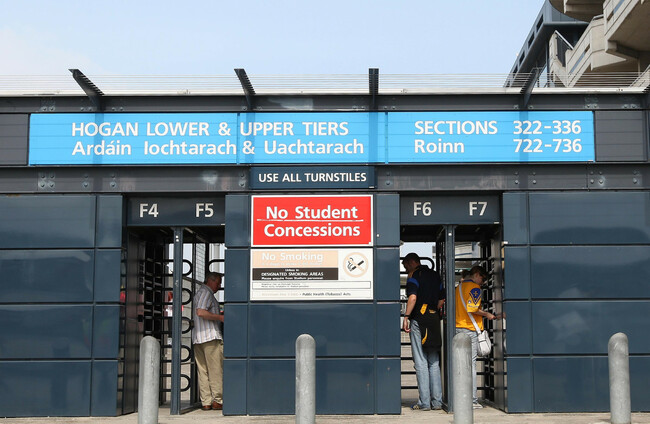THIS COLUMN HAS frequently moaned about the fact Official Ireland does not understand the value of sport, but it sure as hell knows its price.
The Department of Sport this year formalised the country’s policy on deciding whether to host major events, and its hierarchy of rules won’t surprise you. The first principle is to ensure an economic return from the event, and the second is to ensure a sporting benefit.
In fairness, if this subjects every potential proposal to a more rigorous cost-benefit analysis, then it’s no bad thing. You may remember Simon Coveney’s bid to bring the America’s Cup to Cork, founded as it was on his dubious claim that the event is third only to the Olympics and Fifa World Cup when it comes to scale. (We’ll put you out of your misery – the sport here is sailing.)
The bid came with the usual ballyhooing that the America’s Cup would only be brilliant for Ireland, as it would add up to €500 million to the economy. (To put that optimistic figure into context – AirBnB said they added the same amount to Ireland in 2022.) But amid mutterings that it might cost €200 million, the Department of Sport didn’t bite and it went to Barcelona instead. Coveney, meanwhile, must console himself with his Crosshaven Sailor of the Month award for July 2024.
Related to this theme is what has proved to be the must-have sporting accessory of 2024: the Annual Economic Impact Report.
You should be familiar with the concept. X sporting body commissions Y accountancy firm/economist/university to add up all the financial good X sport does in the country to produce a top-line figure which can then be waved at the government whenever X sport wants funding.
Horse and Greyhound racing were the quickest out of the traps when it came to these reports, perhaps cognisant of the need to be able to justify the billion-plus of taxpayer’s money shovelled towards them since the Horse and Greyhound Fund came so triumphantly into being more than 20 years ago.
Hence whenever there is criticism of the legislation which doles out roughly €90 million to these two self-proclaimed industries, their defenders swing a one-two of headline figures from these reports, namely the annual economic contribution and the number of jobs supported.
Where the horses and greyhounds led, the FAI and GAA have followed: both lately brought out their own economic impact reports, published within a month of each other.
These reports are not dishonest, but are elegant exercises in putting one’s best foot forward; of generous definitions and abstruse methodology, all in the exercise of finding the biggest top-line figure possible.
All of these sports deserve funding – particularly football, which has suffered from underinvestment for decades – and it seems these reports are seen a means of getting it.
Ireland is a hospitable place for this kind of stuff, what with our world-renowned GDP figures, now widely acknowledged as one of the finest pieces of fiction ever produced by the Island of Saints and Scholars, swelled as they are by the profit-shifting activities of multi-nationals.
Think of our GDP figures like the world rankings in international rugby: a fundamentally inaccurate global indicator to which Fine Gael voters cling to make themselves feel better.
All of these sporting economic impact reports have been GDPified to some extent.
Deloitte’s report for horse racing, for instance, says there are approximately “30,350 full-time equivalent individuals in employment that can be related back to the breeding and racing industry in Ireland. ”
Their report is at least clear in its breakdown of these jobs. Circa 9,000 of these are involved in the core industry - breeders, stable staff, and trainers, for instance – with another 7,000 directly related, such as such as veterinarians and farriers, along with “roles in agriculture, leisure, and hospitality.”
Another 5,500 of these jobs are in the betting industry, and then there are another 8,400 that are supported “through money flowing through the economy”, with the examples given including travel, accommodation, restaurants and bars.
While racing activities obviously bring activity to certain bars, restaurants, and hotels, the vast majority of these will be raking in money from people in other industries too.
This is like the Association of Cold and Flu Sufferers publishing a report to claim they support the employment of all of the country’s GPs: yes, the doctors are treating you, but they are not treating only you.
The most recent economic report done for greyhound racing, meanwhile, conducted by economist Jim Power, claims it supports 4,150 people in direct and indirect employment. This includes 300 people in the manufacture, sales and distribution of dog food. Sure there are greyhounds eating dog food, but so are non-racing, domestic pets. Would Ireland’s Dog Food Inc. fold tomorrow if greyhound racing was banned?
Again, the language is subtle and clever and accurate: these sports “support” these jobs, rather than being responsible for them. But when their respective levels of funding are defended, the topline job numbers are invoked as if they would disappear without the sport. The truth is muddier.
The FAI this year got on board the Economic Impact train, with accountancy firm BDO finding that the League of Ireland is worth an annual €164.7 million to the Irish economy, totalling the money spent by clubs, fans, the league, and broadcasters, along with capital investment. It claims the LOI contributes an estimated €40 million in taxes every year.
They say there are 1,646 people “directly engaged” with the LOI – they don’t say “employed” as this total includes volunteers. The report also claims there are another 4,448 full-time equivalent jobs supported by the LOI, though doesn’t give any more details.
The same report also reflects on the intangible benefits of sport, including physical activity, mental well-being, and social cohesion.
“The economic and societal impact of such services should not be underestimated”, concludes the FAI’s report.
The GAA came along a month later and decided they should quantified. Their report with Sheffield-Hallam University came back with a bombastic headline: Gaelic Games is worth €2.87 billion every year to the Irish economy. This is slightly more than Ibec estimate the drinks industry contributes here every year.
The GAA figure includes ladies football and camogie, and so will be used by the three parties as a benchmark when looking for money to address the costs of integration.
(It also found that the government receives €192.6 million in direct and indirect taxation from Gaelic Games – with audits of county boards now ongoing, it appears Revenue suspect that figure might be on the conservative side.)
While the LOI report did not try to put a price on sport’s intangible benefits, the GAA’s does. The report is maddeningly light on sourcing, but it claims that the GAA adds €1.224 billion worth of “social capital” to Irish life, in a section that reads like Numberwang.. Another €1.056 billion in value is added, it says, as it would cost that much to replace the GAA’s remarkable number of volunteers.
It’s at this point the absurdity of this exercise becomes clear: it’s frankly insulting of the GAA to put a price on their volunteers. GAA members volunteer because they are not paid. Who on earth would subject themselves to that kind of hassle for money? Volunteers involve themselves to feel like they are playing a role in their community, to give back to the organisation, and to feel part of something greater than themselves.
Putting a price on volunteerism is a contradiction in terms, but is evidently something the GAA deemed necessary in the battle for funding.
If ever it needs to prove its worth to The 42, this column could of course run an Annual Economic Impact report of its own. While it directly supports one (1) job – I don’t have a wide team of writers, I’m not Jimmy Carr – the payment for its production cascades through the local economy, indirectly supporting a huge number of jobs in the coffee and chicken fillet roll sectors. So given the coffee industry is worth an annual €130 million to the Irish economy and the as-yet-unquantified chicken fillet role industry can hardly be worth much less, this column can be said to contribute €250 million every year to the Irish economy. And that’s a conservative estimate.
With these economic impact reports, perhaps it should be a case of hating the game rather than the players. All of these respective sports deserve their funding, but are knocking out these documents because they are playing by the State’s own rules. This is more literature to show we still struggle to understand the true value of sport if we can’t stick a euro symbol on it.














That club tweet is stuff of legends – “The winger has played for clubs like Huddersfield, Norwich City, Cardiff City. Bow down to the Pil”KING”ton”
Might move over there myself wonder what they would say about an old goat with 4 legs?
@Seagoat returns: old goat 4 legs in India??? Definitely becoming biryani !
@yoloboyz: you would be much mixed into it too pigeon